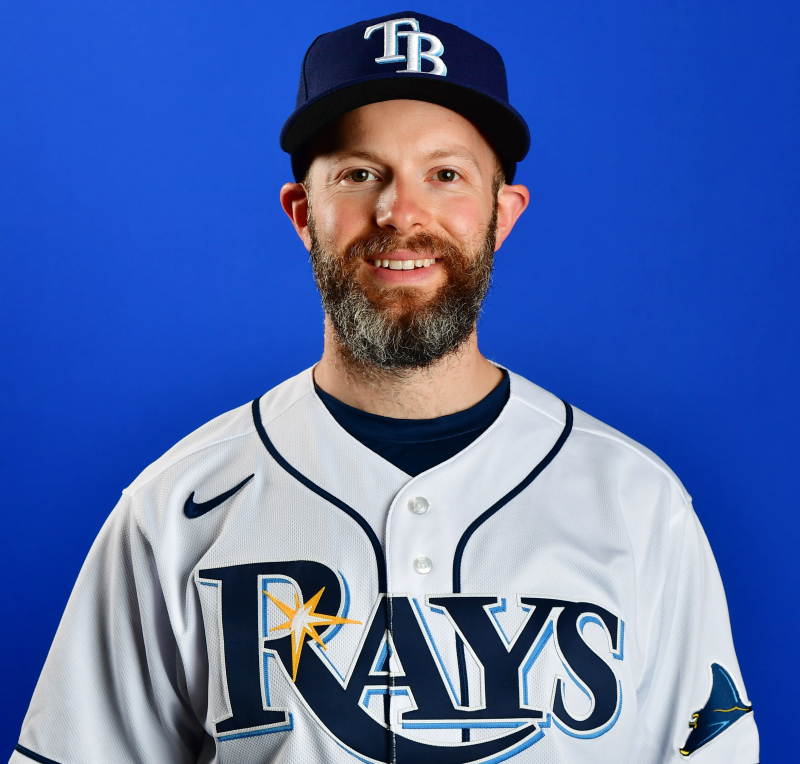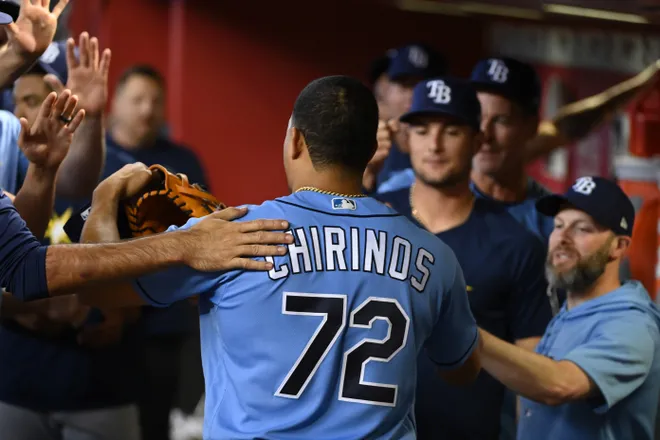Rays coach Jonathan Erlichman is Tampa Bay's dugout Jedi – even if he didn't play baseball
There’s a certain disjointed yet balletic grace when a Major League Baseball team takes batting practice, the chaos of hitters wailing at softly tossed pitches interspersed with coaches ripping grounders to infielders, the balls making their way home through an unspoken human conveyor belt.
And even if the coaches are north of 60 years old, hey, they never quite lose the rhythm of the ritual, even if it’s been decades since they last played.
In this landscape, Jonathan Erlichman stands out.
You might catch the Tampa Bay Rays coach hanging near the buckets of balls by home plate, glove on hand, catching incoming tosses from infielders. Yet his base is not wide, his body almost settling under the ball like a kick returner awaiting a fair catch.
Once the game starts, and Erlichman posts up in the bench area, he might be the one flinching when a line drive screams toward the dugout rail, his internal clock not nearly as conditioned to react with aplomb as his peers.
FOLLOW THE MONEY: MLB player salaries and payrolls for every major league team
Yet with every passing season – and this is Erlichman’s fifth as the Rays’ process and analytics coach – the fact Erlichman never played baseball past his early childhood becomes less noticeable to the naked eye. You can see it in Erlichman’s movements in and around the clubhouse and dugout, a man certain no one will ask for rank, serial number and big league service time as a method to justify his presence.
And as the Rays churn through players yet remain one of the game’s most consistently excellent franchises, headed for the playoffs just as they’ve done in every year of Erlichman’s dugout tenure, the word is out around the league.

'He's a huge part'
The decision to move a Princeton grad and front office analyst to the dugout is more than just another outside-the-box maneuver. Instead, the slight and bearded Erlichman has emerged as yet another secret weapon in Tampa Bay’s run of success.
“They win a lot of baseball games there,” says Miami Marlins shortstop Joey Wendle, a Ray from 2018-2021, “and everybody knows he’s a huge part of that.”
It’s evident enough when manager Kevin Cash or pitching coach Kyle Snyder approaches Erlichman, the heat of a game situation bearing down, and asks for some snap guidance on a move. There is no iPad to consult, maybe just a chart, but most of it simply between the ears of a 2012 Princeton grad who might nudge his grizzled superiors one direction or the other.
And that’s fine: After all, it was Cash who empowered Erlichman in the first place.
When the Rays pondered moving Erlichman from the army of analysts in the controlled environment of the front office, Cash made several phone calls to veterans in the winter of 2018. The message: Jonathan’s coming downstairs, and we are all going to accept it.
“Cash said he wanted to give everybody a heads up,” says former Tampa Bay Gold Glove center fielder Kevin Kiermaier, now a Toronto Blue Jay, “because we rely on him and use him and we want you guys to accept him.
“Because baseball players, we try to limit the people who are in the dugout a lot of times. And that was kind of the new wave with the analytical department - you start seeing other staff members or personnel in the dugout and that was the transition into it.”
Indeed, the sea change likely began with the Houston Astros, who embedded Sig Mejdal, their director of decision sciences, with their short-season Class A team for three months in 2017. As the Astros raised eyebrows throughout the game with a cold-blooded push toward optimization, which indirectly culminated in their sign-stealing scandal, the Rays were building their own thing.
Yet the Rays way, if you will, was as much about culture as it was quants. Hence, Cash’s firm heads-up to his top players.
Erlichman felt that.
“Everyone was really welcoming and helpful,” says Erlichman. “We’ve had a really good environment here. I had a really good relationship with Cashy from before when I was in the front office so that always helped a lot.
“We’re all just trying to help all the players, get the most out of them, turn them into the best players they can be. Anything we can all do to help us get better and win more games, everyone is happy with all that.”
It’s hard to argue with the results. Tampa Bay is 417-286 since the start of the 2019 season, including a World Series trip during the pandemic-shortened 2020 campaign. Erlichman, who is also respected for his player evaluation acumen, says his gameday presence has enabled he and his colleagues to further bridge the gap between front office and dugout.
“Being here in the moment for a lot of those conversations over the last few years has led to us building out more tools to help with those decisions that maybe we hadn’t thought about building before,” says Erlichman. “Being there and having conversations, hearing the conversations that the rest of the staff was having within games has helped us develop that process better.”

'He just doesn't look like an athlete'
The gig also brought its share of personal adjustments.
A baseball season is epic-long, regardless of an employee’s station in the organization. Yet while the physical toll is not exacted on the everyday major league staff, the grind – the travel, the relentless schedule, the tunnel with seemingly no end – is very much real.
Particularly for a guy who didn’t, in fact, ride the busses in the minor leagues or navigate a 162-game schedule.
“The first season,” say Erlichman, “I wasn’t fully prepared for the difficulty of getting through an entire season and how to maintain myself a little bit physically, with all the travel, but moreso mentally to be in a good place for an entire eight months. There’s a lot of habits I’ve learned over time to help keep myself in a better place over that long schedule.
“For me, personally, I’ve just found prioritizing sleep quality has been the biggest thing that’s helped me over time.”
But the insane schedule has its rewards. Baseball is a game best learned through immersion, and while high-speed cameras and high-def monitors and artificial intelligence are all crucial tools in decision-making processes and player evaluations, there’s nothing quite like the in-person experience.
Yes, the grind makes everybody better – even the most non-traditional employees.
“There’s a lot of things I’m able to see now I wasn’t able to see before, when I was in a role further apart and away,” says Erlichman. “The ability for me to see things from year one to year five now, my eyes have gotten a lot better just from all the reps and seeing things and leaning on our staff and players and really learning a lot from them.”
That’s certainly a two-way street.
“I think he has a lot of influence and a lot of pull,” says Kiermaier. “They definitely lean on him. He’s a numbers genius and that’s a big part of the game today.”
The comfort level has risen with the track record. Rays players and staff affectionately call Erlichman “J-Money,” and he in turn has relaxed in the environment, even picking up rudimentary Spanish in chatting with the Rays’ Latin American players.
Even if it’s not so easy to fade into the tapestry.
“You look at the dugout and it’s like, one of these things is not like the other,” says Wendle. “He just doesn’t look like an athlete and would probably be the first one to tell you.”
That’s OK, says Erlichman. He hasn’t made it a huge priority to hone his baseball skills so as to facilitate drills; after all, as many an I-could-do-that adult might be wise to learn, hitting fungoes effectively is an art, honed over many years.
No, Erlichman will stick to his strengths, five years after he was tossed into the game’s fast lane yet managed to carve out his own. There’s no telling where it may lead, simply because there’s very little Erlichman hasn’t proved he could do.
“He definitely has come a long way from his first time being around everybody and the game in general,” says Kiermaier. “But he’s doing well and I think he’s going to be around the game for a long time.”

Disclaimer: The copyright of this article belongs to the original author. Reposting this article is solely for the purpose of information dissemination and does not constitute any investment advice. If there is any infringement, please contact us immediately. We will make corrections or deletions as necessary. Thank you.







